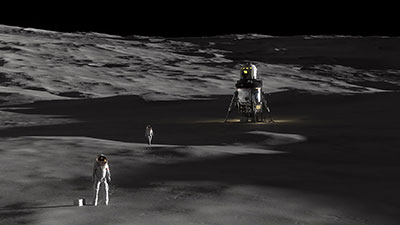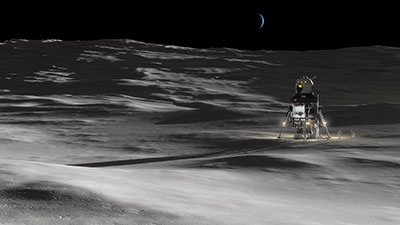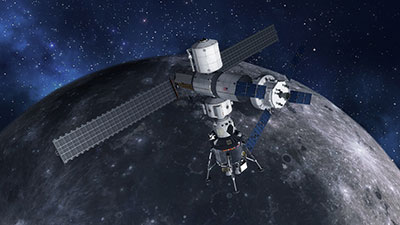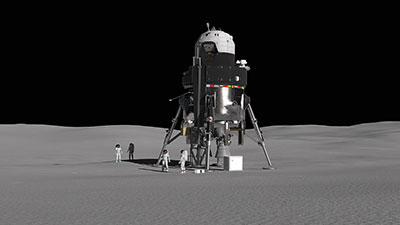Ahead of the CurveAs the fascination with deep space exploration grows, commercial opportunities will follow. Companies are developing commercial lunar concepts and business plans.
NASA's lunar Gateway can be a cornerstone to the development of a new commercial lunar economy. Like the transcontinental railroad or commercial airports, government developed infrastructure will be critical to the viability of a commercial market based in cis-lunar space. Early commercial applications will be privatized services to NASA, such as current commercial cargo and crew to the International Space Station. Other purely commercial activities may follow and could turn in to a true production-based economy around the Moon.
The Infrastructure: Gateway
The Gateway is the proving ground to take humans farther than ever before. It is essentially a "space port" where astronauts will be able to perform revolutionary science, establish a lunar commercial economy, and build and test the system elements to get us to other destinations such as the surface of the Moon, asteroids and Mars.
NASA's Gateway concept has been adopted by the international community and is the space port to promote sustainable lunar operations and develop extended international partnerships. Serving as the main hub, the Gateway will provide a place to both live and work and is flexible to support multiple missions. First, this orbiting port will be the communications hub for explorers because they will need high-speed communications relays, imagery and mapping, and navigation help from lunar orbit. The Gateway can perform all of those functions from the high-ground vantage point and by utilizing low-cost hosted payloads rather than a full network of lunar satellites.
In addition to communications, the Gateway will be a future fuel depot that will provide the springboard needed to get tomorrow's space economy off the ground. Rockets, satellites and spacecraft can fuel-up for missions between the Earth and the Moon without having to land on the surface – and ultimately longer-duration missions to destinations like Mars.
The Workhorse: Orion
NASA's Orion is the world's only exploration-class spacecraft, designed and built to protect astronauts from the dangers of deep space. Orion will support an incremental buildup of the entire Gateway and is a highly capable vehicle with unique features designed to meet deep space environments and keep crew members safe even given dangerous emergency scenarios.
Other human spaceflight vehicles aren't designed for the challenges beyond low-Earth orbit. They also lack the capability to fly long duration missions and are ground dependent. Orion is designed with advanced technology needed for the extremes of deep space, such as long-duration life support, deep space navigation, radiation protection, deep space communications and a robust heat shield capable of Mars-return velocities.
Orion will also serve as the exploration command deck for when the Gateway is crewed. Built on a robust fault tolerant design and capable avionics system, Orion provides the safe control and necessary interfaces for crew to perform a variety of missions. Should an anomaly occur while in lunar orbit, the crew can also use Orion as a safe haven while they continue to work to resolve the issue or safely return to Earth. The investments already made in Orion can be leveraged to reduce the cost, complexity and development timeline for the Gateway.
The Surface: Landers
From the orbital platform of the lunar Gateway, we can begin to explore the surface of the Moon with a reusable crewed lunar lander (White Paper: Concept for a Crewed Lunar Lander). After a surface mission, it would return to the Gateway, where it can be refueled, serviced, and then kept in orbit until the next surface sortie mission.
With help of the Gateway, astronauts will scan the lunar surface to determine the best landing spot that will be rich with resources and ideal for a potential lunar colony. Scouting allows us to find the optimal landing spot to sustain the first city on the Moon.
Using the orbiting Gateway as a departure base makes a reusable crewed lander simpler and safer as opposed to an Apollo-style direct-to-surface mission. The lander only needs enough capability to bring a crew and some cargo to the surface, and not large pieces of infrastructure to bring people back and forth from Earth. Our crewed lunar lander concept is a single stage, fully reusable system that incorporates many of Orion's flight-proven technology including its avionics and a light-weight version of its crew module pressure vessel.
After a surface mission, the lander would return to the Gateway, where it can be refueled, serviced, and then kept in orbit until the next surface sortie mission. Keeping the reusable lander at the Gateway while having Orion return the crew home to Earth simplifies the design and cost of the lander by removing the need for complex entry, descent and landing systems, which is the most dangerous phase of the mission.















